Last updated: April 19, 2022
Article
Gourd Art: Telling Stories From Powhatan Culture

NPS
Ethan Brown is a citizen of the Pamunkey Indian Tribe. The Pamunkey Indian Tribe is a federally recognized tribe in the United States, and the Pamunkey Indian Reservation is one of the two oldest reservations in the country.
Ethan is an artist who creates contemporary art in many different forms and mediums, including gourd art, wood sculpting, oil painting, pottery, and filmmaking.
Below, Ethan discusses his gourd artwork in his own words. He describes three of his gourds, each of them telling a different story about Powhatan culture and life at different times throughout history.
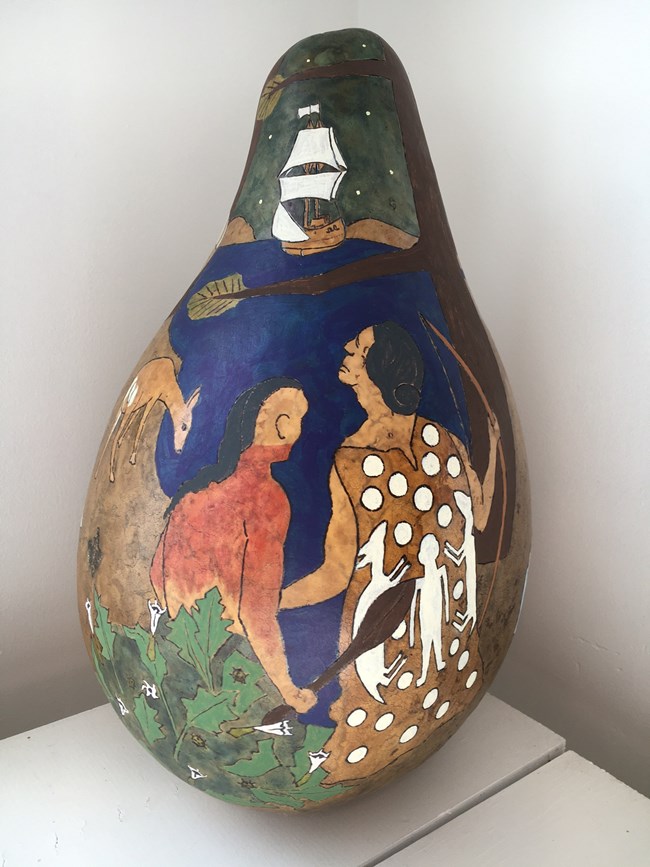
Powhatan Culture c. 1600 Gourd
Look at this first gourd, it is meant to show different aspects of Powhatan culture circa the 1600's. Imagine what it would have been like to see those first European ships come up the river.
The figures in the foreground- the one on the left wears his hair long on the left, cropped in the middle, and shaved or plucked rather on the right side. I've read speculation that this was so that the bowstring wouldn't get caught in our hair, though like most things there are spiritual connotations as well. We wore our hair in the image of one of our idols. This was the man's haircut. Powhatan society very much had separate roles and customs for the sexes. The men hunted and fished and were warriors. The women farmed and built the houses and cooked. These are just generalized roles to give you an idea, in some areas there would obviously be exceptions. We weren't a society based on agriculture, though it was a component- you've heard of the three sisters corn, squash, and beans- these were some of the main crops. We had some more permanent settlements but often villages were temporary and moved to different areas of the territory according to the seasons- which plants were ready to harvest, where the animals were, etc.
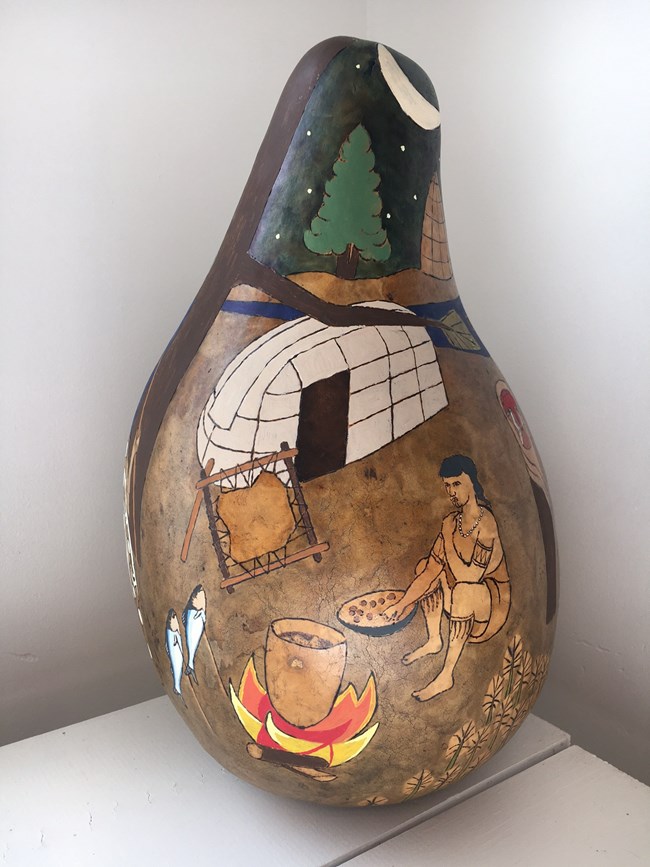
The figure is holding a war club and is painted in a red dye made from bloodroot. We often painted ourselves and the different colors had different connotations. Red, Black, and White were the most important colors. Women would tattoo their skin with designs and animals. The figure in the gourd to the right holding a bow is depicted wearing "Powhatan's mantle", one of the surviving artifacts from the 1600's. It is speculated if it actually belonged to Powhatan, or if it was actually worn as garment. I'm not going to speculate on its meaning but just wanted to highlight it. It was made of four deerskins sewn together and white shell beads stitched to form the circles and figure of man and animals on either side. Each village was ruled over by a Werowance, or chief, and at the time of English arrival all of the tribes in the region had an allegiance under Powhatan, the Mamanatowick, or paramount chief. The power structure of this society was Matrilineal.
Keep following the gourd to the right; here you see a longhouse which is the type of structure we lived in. It would be made of bent saplings and covered in bark siding or reed mats. Outside you see a deer skin stretched and ready to be worked. The majority of our clothing came from skins and furs. Women made pottery from the clay from the river which were used as storage and cooking vessels. Here a woman sits by the fire and sorts through an acorn harvest as a stew bubbles. Some fish are being smoked. The rivers were the lifeblood of our culture- for the bounty of food and as a mode of transportation. Trees were felled and the inside burnt out to make dugout canoes. Men fished with spears and set traps and stretched nets across the waters.
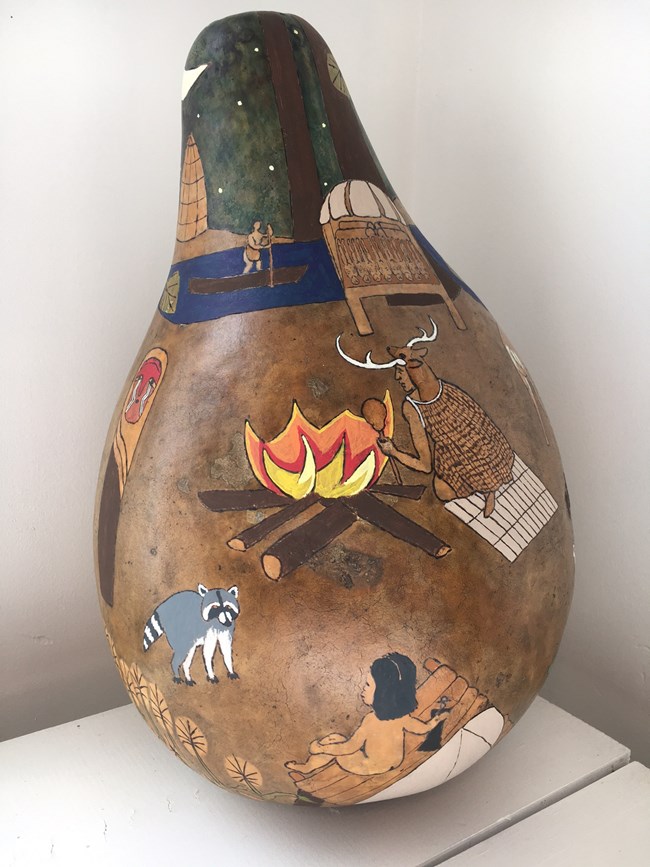
In the middle of the gourd is a totem to warn of the evil spirits. These would be set up in dance circle for ritual and ceremony. At the very top of the gourd in the distance you see a Huskanaw pen. When a young boy of the upper rung of society came of age, he would be ceremoniously kidnapped and live away from the tribe for many months and put through a rigorous coming of age ceremony by the priests and at some point be contained in the pen while he was sedated and drugged, perhaps with jimsonweed, and a sort of rebirth would take place, he would forget his childhood and family and come back to the tribe as a man, no longer to serve or acknowledge his parents, but to take a wife and serve the chief from then on.
Come down to the bottom of the gourd, there is a field of corn to the right of which a child sits on a raised platform keeping watch to scare off any animals that might try to steal the harvest.
Up and to the right is a priest watching over a fire in front of a temple. It is depicted in the scene for the sake of the artwork, though in reality a temple would have been located away from a village. Only the Priests and the chiefs were allowed into them. They housed the bodies of past chiefs which were flayed and defleshed and allowed to dry out and then the skeleton replaced in the dried skin and the joints filled with sand and the cavity with pearls and shell beads and copper.
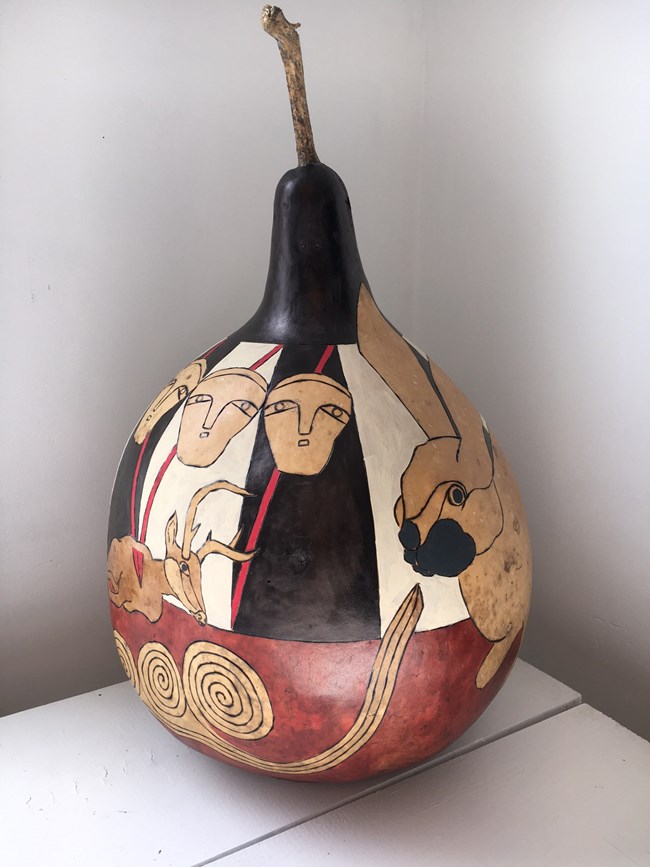
Creation Myth Gourd
When you sit around a fire with your tribe in the evenings, storytelling becomes an important aspect of your culture. This second gourd is an example of that. The Powhatan didn't have a written language- anyone who has played a game of telephone knows that stories are liable to change when they are passed on orally, so this story has many variations. It is a creation myth. It goes like this:
The greatest of all the spirits sometimes took the form of a Great Hare.
He came from the land of the rising sun and carried with him a magic bag which he kept Man and Woman inside of. He went about creating the mountains and the rivers and forests and then placed a great deer upon the land that he had created.
Now there were these four old female spirits that watched this and were jealous of the Great Hare and this land that he had created and so one night when he was away, they assumed the form of giants and with long hunting poles, slew
the great deer and ate his remains.
It was then that the Great Hare called upon the winds of the four directions and scattered all the
little hairs of the great deer about the land...
...each little hair in turn becoming a lesser deer. The Great Hare then pulled Man and Woman from his magic bag and placed them into the land to live in harmony and have sustenance.
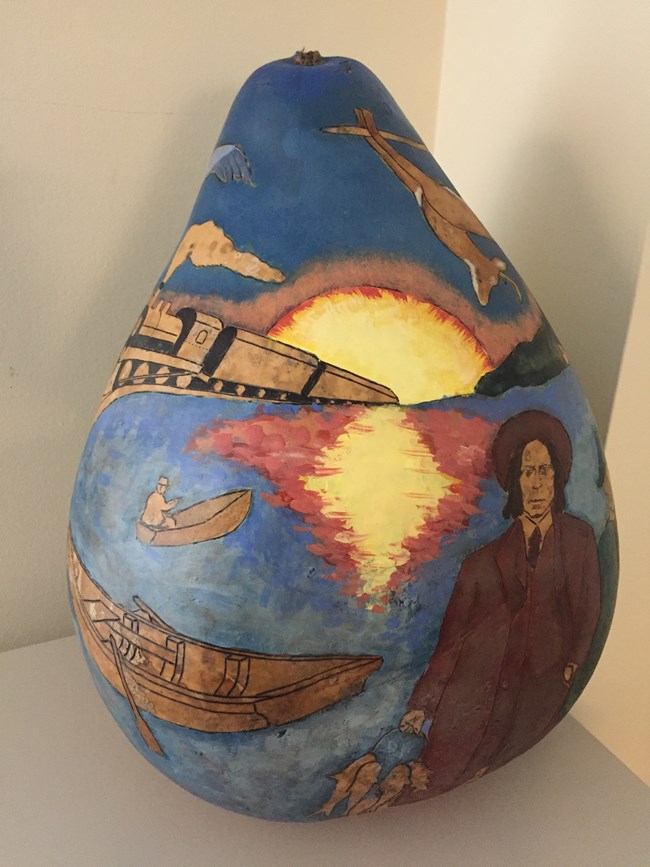
Pamunkey Culture c. 1900 Gourd
The sequence of events from the early 1600's until now would take books to fill. My tribe, the Pamunkey, had our Reservation established with the treaties of 1646 and 1677 and though it has been vastly reduced in size since then, we still reside on land that has never been taken away from us. Those treaties also established our annual tribute that we pay to the Governor of Virginia, a tradition that continues to this day. That is what the deer in the sky of the last gourd is in reference to- we take a deer to the Governor's mansion each year on Thanksgiving.
This last gourd is to give an impression of life on the Reservation in the early 1900's. Our community had been forced to adapt in order to survive and preserve our identity until that time, and even since then there have been many efforts to say that there are no more Indians in Virginia, so ours is really a story of survival. We were really a small country community at this time. The river still provided food and jobs and many of the men on the Reservation fished for shad or trapped to ake a living. Some acted as guides for hunting groups. Here on the gourd are two Pamunkey men back from fishing.
George Major Cook on the left holds the catch in his hand. He was the chief for many years around this time. As you can see they are no longer wearing deerskin clothing but suits and work clothes just like anybody else.
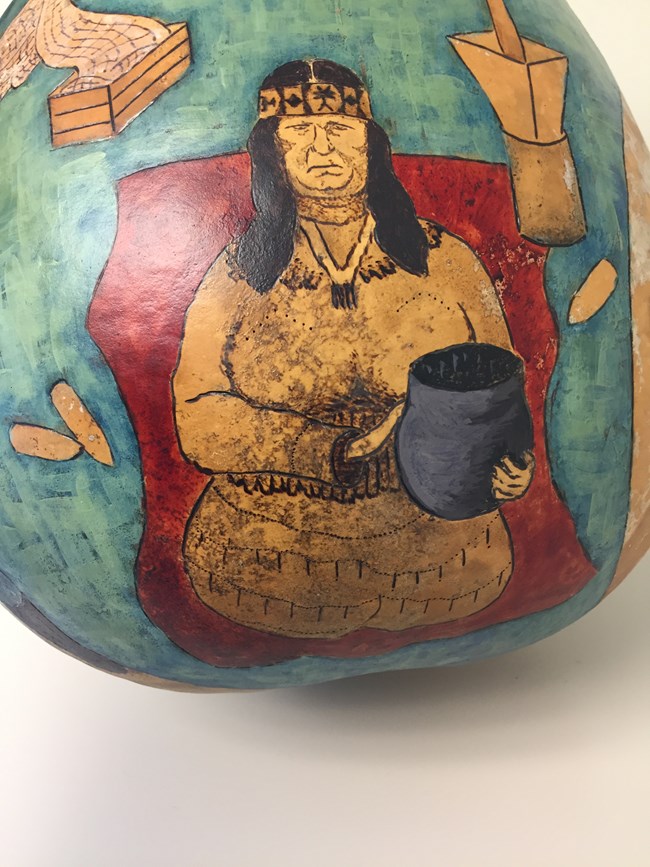
To the left by the railroad track, you can see a deadfall trap used to catch small game. Row boats were used now instead of canoes but they still stretched nets across the river and fished the tides.
The sun sets on the Reservation in this special place we call the pocket, and oral tradition has it that Powhatan's bones were moved here and buried. In the background on the horizon a duck hunting blind can be seen.
To the right of the figures some fishing nets drape over a post to be straightened.
Continuing on, you have the Pamunkey Baptist church that was the heart of our community at this time.
Theodora, George Major's wife, can be seen at the bottom holding a piece of pottery, a tradition that continued with the women of the tribe. She is depicted in deerskin regalia, though this was no longer daily wear but used for special occasions. A pottery school was built on the reservation in 1932 as a way for the women to commercialize the craft to make money during the great depression.
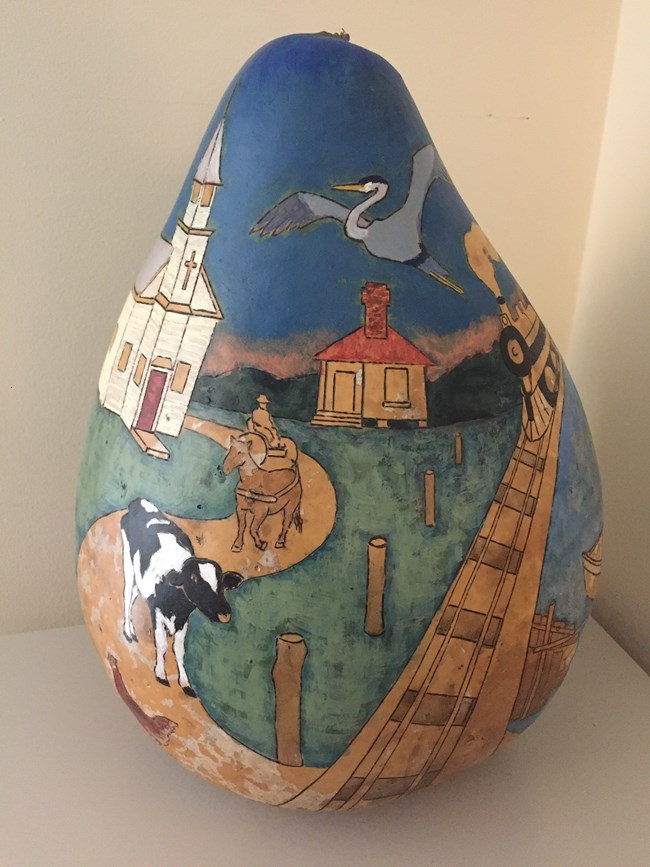
Times were hard back then, and every family lived the self-sufficient lifestyle, growing big gardens and preserving food. Everyone had chickens and pigs and cows and a horse. They were horse and buggy days, with dirt roads. In the background you can see the old school house. Pamunkey children weren't allowed to go to public school and if they continued education after the grade school here they were sent to Indian schools out west or in other parts of the country.
So that is the condensed story that these gourds depict. When you are in Virginia, on the shore, or planting a tree in your backyard, keep your eyes peeled because it is possible you might find a pottery shard from a culture reaching back thousands of years.
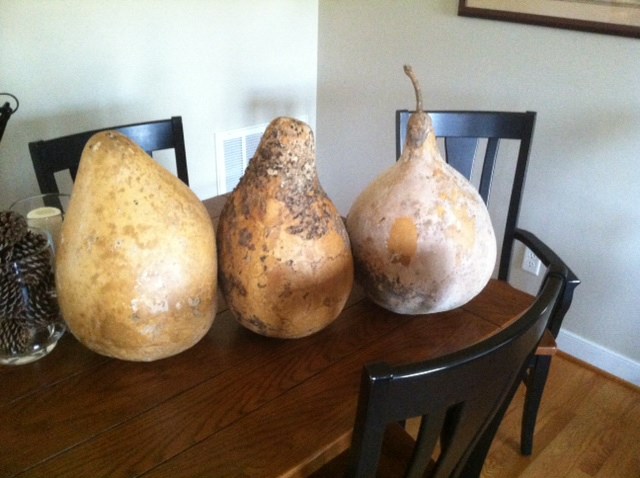
Background
These gourds are meant to give an impression of Powhatan culture. They are coming from my experience and perspective, I live on the Pamunkey Indian reservation, and these were my ancestors. So much of our traditional culture has been lost, though many traditions remain. You could read all of the history books written about the Powhatan and talk to all of the descendants of these original people and you would still be left with a skewed view of who the Powhatan were and what their culture was about. I'm sure the same could be said for any culture around the world for history and human beings are complex and varied and everything is relative.
The little that the English did record about Powhatan culture, they were often frustrated by because they would receive different or conflicting accounts and views depending on who they talked to. Maybe that variation can be attributed to the Powhatan not having a written language, or maybe that speaks to something deeper. So these gourds are just meant to give a broad impression, leave the rest to your imagination.
The Powhatan were woodland people. They lived in this area of tidewater Virginia for over 10,000 years. Everything about Powhatan culture: food, materials, processes- came from and was intertwined with the natural world in which they lived, a much different world than what you see in Virginia today; an old growth forest that stretched the entire east coast. The trees were huge and the rivers much more abundant with life. All of that connected old growth has since been cut down and so it is just a different landscape now.
When your entire lifestyle is intertwined with nature, you end up being mostly sustainable, but even resource management was an issue for the Powhatan. Some people try to make the American Indian out as being some kind of nature saints that protected the planet and didn't waste anything, but any of that was out of necessity; we were just Human Beings, and I think history shows that we were just as opportunistic as anyone else.
